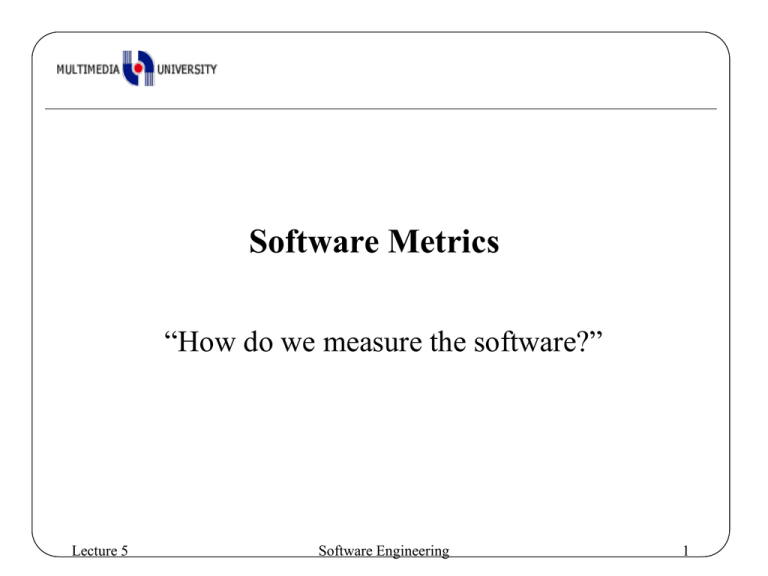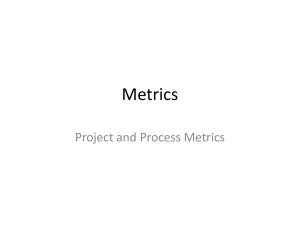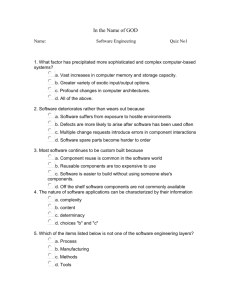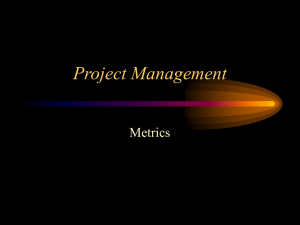TCS 2411 Software Engineering
advertisement

Software Metrics “How do we measure the software?” Lecture 5 Software Engineering 1 Lecture Objectives To understand the importance of measurement in software engineering To describe and compare the different metrics that can be used for measuring software To understand the important factors that affect the measurement of software Lecture 5 Software Engineering 2 Engineering Method Lecture 5 Scientific Precision Accuracy Repeatable Controllable Quality Software Engineering 3 Why Do We Measure? To indicate the quality of the product To assess the productivity of the people who produce the product To assess the benefits derived from new software engineering methods and tools To form a baseline for estimation To help justify requests for new tools or additional training Lecture 5 Software Engineering 4 Definitions Measure - quantitative indication of some attribute of a product or process Measurement - the act of determining a measure Metric - a quantitative measure of the degree to which a system, component, or process possesses a given attribute (IEEE) Lecture 5 Software Engineering 5 What Can Be Measured? Direct measures Lines of codes (LOC), speed, cost, memory size, errors, ... Indirect measures Quality, functionality, complexity, reliability, efficiency, maintainability, ... Lecture 5 Software Engineering 6 Size-Oriented Metrics Based on the “size” of the software produced Project data measured, including cost and effort Advantages: easily counted, large body of literature and data based on LOC Disadvantages: language dependent, programmer dependent Useful for projects with similar environment Lecture 5 Software Engineering 7 Example of Project Measurements project effort (personmonth) cost ($) aaa-01 24 168,000 12.1 365 29 3 ccc-03 62 440,000 27.2 1224 86 5 Lecture 5 kLOC Doc. errors people (pgs) Software Engineering 8 Example of Size-Oriented Metrics Productivity = Size / Effort = kLOC / person-month Quality = Errors / Size = Errors / kLOC Cost = $ / kLOC Documentation = pages / kLOC Lecture 5 Software Engineering 9 Function-Oriented Metrics Based on “functionality” delivered by the software Functionality is measured indirectly Function points (FP) - derived using an empirical relationship based on countable measures of software’s information domain and assessments of software complexity Lecture 5 Software Engineering 10 Software information domain values Number of user inputs Number of user outputs Number of user inquiries Number of files Number of external interfaces Lecture 5 Software Engineering 11 Steps In Calculating FP 1. 2. 3. 4. Count the information domain values. Assess the complexity of the values. Calculate the raw FP (see next table). Rate the complexity factors to produce the complexity adjustment value (CAV) 5. Calculate the adjusted FP as follows: FP = raw FP x [0.65 + 0.01 x CAV] Lecture 5 Software Engineering 12 Function Point Metrics Weighting Factor Parameter Count Simple Average Complex Inputs x 3 4 6 = Outputs x 4 5 7 = Inquiries x 3 4 6 = Files x 7 10 15 = Interfaces x 5 7 10 = Count-total (raw FP) Lecture 5 Software Engineering 13 Rate Complexity Factors For each complexity adjustment factor, give a rating on a scale of 0 to 5 0 - No influence 1 - Incidental 2 - Moderate 3 - Average 4 - Significant 5 - Essential Lecture 5 Software Engineering 14 Complexity Adjustment Factors Does the system require reliable backup and recovery? Are data communications required? Are there distributed processing functions? Is performance critical? Will the system run in an existing, heavily utilized operational environment? Lecture 5 Software Engineering 15 Complexity Adjustment Factors (Continued) Does the system require on-line data entry? Does the on-line data entry require the input transaction to be built over multiple screens or operations? Are the master files updated on-line? Are the inputs, outputs, files, or inquiries complex? Lecture 5 Software Engineering 16 Complexity Adjustment Factors (Continued) Is the internal processing complex? Is the code designed to be reusable? Are conversion and installation included in the design? Is the system designed for multiple installations in different organizations? Is the application designed to facilitate change and ease of use by the user? Lecture 5 Software Engineering 17 Complexity Adjustment Value The rating for all the factors, F1 to F14, are summed to produce the complexity adjustment value (CAV) CAV is then used in the calculation of the function point (FP) of the software Lecture 5 Software Engineering 18 Example of Function-Oriented Metrics Productivity = Functionality / Effort = FP / person-month Quality = Errors / Functionality = Errors / FP Cost = $ / FP Documentation = pages / FP Lecture 5 Software Engineering 19 FP Characteristics Advantages: language independent, based on data known early in project, good for estimation Disadvantages: calculation complexity, subjective assessments, FP has no physical meaning (just a number) Lecture 5 Software Engineering 20 Extended Function Point Metrics Feature points applied to systems and engineering software includes assessment for algorithms 3D Function points applied to real-time systems and engineered products (by Boeing) integrates data dimension (normal FP) with functional and control dimensions Lecture 5 Software Engineering 21 Reconciling Metrics Approaches A number of studies attempted to relate FP and LOC measures Relationship depends on programming language and quality of design Example: one LOC of Ada provides approximately 1.4 times as much “functionality” (on average) of one LOC of Fortran Lecture 5 Software Engineering 22 Comparison of LOC/FP Programming Language Assembly Language C Cobol Fortran Pascal Ada Object-oriented language Fourth-generation language Code generators Lecture 5 Software Engineering LOC/FP (average) 320 128 105 105 90 70 30 20 15 23








